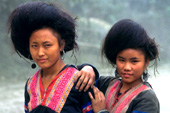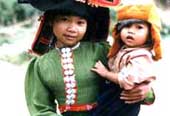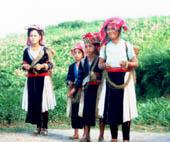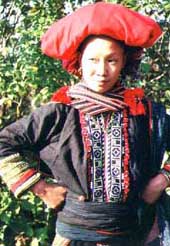 |
||||||||||||||||||||||||||||||||||||||||||||||||||||
|
With nearly 500,000 inhabitants,H'Mong (Meo) ethnic group occupies 0.8% of the Vietnamese population. Coming from South-China some hundreds of years ago, they belong to Meo-Dao linguistic group and live mainly in Lao Cai, HaGiang, Tuyen Quang. H'Mong ethnic group grows maize, opium, subtropical fruits and vegetables, breeds cattle and hunts wild animals. "TÚT MEO" - NEW YEAR FESTIVAL OF THE H'M¤NG PEOPLE This is the name other fraternal peoples give to the New Year festival of the H'Mong - an ethnic minority residing on the high-mountain regions of Vietnam, ranging from the Sino-Vietnamese border in the North to NgheAn province in the centre of Vietnam. The H'Mong have developed their own calendar to calculate times of year for farming on their burnt-over land and wet-rice terraced fields. They also have their own way of identifying the date of the New Year. Perhaps no one has studied the coincidence in the timing of "Tet Meo" - the New Year festival of the H'Mong - and the Christian New Year week lasting from Christmas (December 25) through to the first day of January. At this time, peach blossoms bloom resplendently all over the H'Mong hamlets, amidst the soft and white mists. To prepare for Tet, the H'Mong put their house in order, redecorate the altar with pieces of paper cut out with stylized images of the Sun - a manifestation of the Sun-worshipping practice of the H'Mong people. These stylized drawings of the Sun are also stuck to the doors to welcome the New Year and prosperity for the family. Smaller versions (approximately 5cm x 10cm) of Sun drawings are stuck on working tools such as the hoe, plough, rake, etc. as well as on pigsties, buffalo stables, horse enclosures...... and reflect the earnest desire of the people to welcome prosperity to every element of their life. During this time, women are occupied with dressmaking and embroidery so that each family member has a smart set of clothes to wear to welcome the New Year, the most special of which is the typical dress of the H'Mong women. On New Year's Eve, every family kills a black-and-red-feathered cock to offer in worship to the deities and ancestors. When killing the cock, they pick out bundles of red feathers and stick them with the cock's blood to the middle of the decorations of stylized Sun pictures. The cock-killing and sticking of cock feathers to the Sun drawings is considered a crucial part of the New Year-Welcome rituals of the H'Mong. This act is seen as an inseparable part of the rite of welcoming the New Year and a sign for the festivities to begin. Throughout the 7 to 8 days of Tet, the H'Mong families in each subhamlet (consisting of several houses nestling on one or two mountain slopes) take turns to kill their pigs to host group feasts. The host family commences the party by a ritual service inviting deities and their ancestors to return to join the family in celebrating the New Year in the presence of other groups of families. Only after that can the party begin in a festive atmosphere filled with laughter and the voices of all generations - elders and young, women and men, adults and children... Many feasters stay up overnight around the family fire to teach and learn songs together comprising the H'Mong service hymns, love and courting songs, kinship songs, proverbs, etc. Particularly on the first day of the New Year, the H'Mong belonging to the same group or village automatically gather in a large yard or a flat ground to take part in or to cheer traditional games amidst melodious tunes of the khen (pan-pipe), lip organ, leaf organ....The most popular game that draws a lot of participants and fans is papao shuttle. Papao is a small ball made of cloth, which is thrown between two teams - women and men. Once the ball is cast into the air, it is caught by someone in the other team. At first, the casting and catching acts seem to be natural showing no particular skills. The flying course of the papao becomes an invisible line linking and binding every couple of playmates closer "in tune" with each other. The papao shuttle lasts for hours. Participants become more and more engrossed, and they play untiringly even though the game is just a repetition of two acts - throwing and catching the ball. Naturally, the players who remain to the last minute are always couples of playmates who have fallen in love with each other and exchanged their feelings through the papao. The first happy day of a New Year not only brings a common joy to all people, but also marks the beginning of many love stories of young boys and girls. Many H'Mong couples start their love and nuptial life from the New Year welcoming day. In addition to the papao game, there are other collective events such as Con throw - a game where Con (a fringed cloth ball ) is thrown through a hoop hung at the top of a high post, and the" khen "dance is performed by talented young men who blow khÌn and at the same time dance gracefully and alternately between lines and strong movements. Besides attending communal parties and jolly events in their own hamlet, many H'Mong take their time to visit friends in distant villages while most young people continue their dating and intimate exchanges through singing and blowing lip- and leaf-organs. During "Tet Meo", weddings of the couples whose love had been born from the papao event of the previous year are celebrated, even as new love blossoms and bears fruit by the end of the New Year or at the next New Year festival. "Tet Meo" thus ends with happiness and heralds fresh hopes for the future. (VNS) With about 100,000 inhabitants, Cham (Cham, Chiem, Hoi) ethnic group originates from Ancient Cham Pa Kingdom. They live mainly in Ninh Thuan, Binh Thuan, Binh Dinh, Phu Yen. Belonging to MaLai-Da Dao linguistic group, the Cham people remains influenced by matriarchy and Indian culture. The ancient Cham writing is Sanskrit-based. Hinduism and Mohammedanism are their principal religions. THE UNIQUE CHAM CULTURE The Cham culture is a unique tradition, contributing much to the diversity and richness of the Vietnamese multi-ethnic culture. From the first century AD, the Cham people received deep influences from Indian culture. In the 7th century AD, Cham Pa was already a kingdom with a capital in TraKieu (now Quang Nam) with a temple dedicated to the Indian Valmiki and his famous epic, the Ramayana. By the middle of the 8th century AD, their capital was shifted to Nha Trang and five years later to Dong Duong, 15 km away from Tra Kieu in the southeast. The Cham are one of the 53 ethnic groups in Vietnam and comprise various subgroups. There are around 98,000 Cham people, including the Cham Hroi in Binh Dinh, Phó Yen and those living in Ninh Thuan, Binh Thuan and other parts of southern Vietnam. Inhabiting a large area, the Cham also have many diversified customs and social practices. While most of the Cham in HoChiMinh City, AnGiang and Tay Ninh, and the Cham from Cambodia follow Islam, those living in Binh Thuan, Ninh Thuan provinces follow Brahmanism. Islam is modified to suit the people here and is called 'Bani'. The Cham language is of the Malayo-Polynesian family and is spoken by about 250,000 people (G. Moussay, Dictionaire Cham-Vietnamien-Francais, published by Phan Rang Culture Centre 1971). However, it does not necessarily follow that the Cham in different regions can fully understand each other. It is natural that the Cham borrow local words and expressions at the place they reside, mainly from Kho Me and Vietnamese. In terms of their script, only the Cham Dong (in Binh Thuan, Ninh Thuan provinces) have preserved their original script. The Cham script is now being taught at elementary school to help maintain this unique linguistic tradition. The Cham also utilised the Akhar Thrah scripts from Nam An which has been incorporated into present-day Cham scripts. Ancient texts written on papyrus or paper used both of these scripts and include various epics and love stories such as the Devamuno Inra Patra, Ummurup, Cambini, Bini-Cam, Sah Pakei, Patauw Kamai, Patauw adat Likei etc. This ancient literature gives a clear picture of the life and society of the Cham through history. Together with academic literature, the Cham also have very rich popular literature which comprises hundreds of stories, sayings, idioms, puzzles, songs etc., which make up a precious literary tradition. Cham people have songs for fishing using the 'vai chai' rhythm (pwoc jah), betrothals (danh dom da ra), milling rice (danh rasung chai) etc. These rhythms are also sung during festivities with dances which have become a real attraction to spectators. Surely the greatest and most unique contribution from the Cham culture is their architecture and carvings. Historical stupa compounds inMy Son (Quang Nam-Da Nang), Thap Ba (Nha Trang), Thap Cham (Ninh Thuan) and various Tara statues in Dong Duong, and Apsaras in TraKieu have all had their position confirmed in the Southeast Asian sculptural tradition. Though most of these works were created for religious purposes and stemmed from Brahmin spiritualism, they became popularised and part of the Cham national culture. As such, the Indian-inspired Vishnus, and Shivas went through considerable transformations and became more human when recreated by Cham artisans. In the present day, the Cham people have adjusted their lives to local conditions. People in Tay Ninh mostly work in agriculture, fishing and commerce while those who live near HoChi Minh City have developed an urban lifestyle. The majority, however, still maintain traditional professions like cultivation, husbandry, weaving and ceramic production. Cham handicrafts are now exported to various countries where they are highly appreciated due to their unique style and high quality workmanship. (VNS) Divided into Kpa Krung, Adtham, Mthur, Ktul..., Ede ethnic group with more than 160,000 inhabitants living in the heart of Dac Lac Highlands, Khanh Hoa uses the Malayo-Polynesia language. They dwell in stilted houses with sloping roofs. Besides farming and breeding, they hunt wild animals, taming elephants and picking fruits. Their culture is original with many well-known epics. K'PAL AND THE LIFE OF THE EDE PEOPLE : K'pal or "Sacred bench" is an essential feature of all festivities and ceremonies of the Ede, an ethnic group in Central VietNam. It is reserved for the elderly of the village, guests and musicians, and females are strictly forbidden from sleeping on it. The bench is carefully constructed in strict conformity with age-old rules. It is usually 13 m long, 0.7 m wide and about 21 to 22 cm thick, and the whole process of making it must be completed within seven days. To make a k'pal, the head of the family first makes an offering to the god Giang Wah Yang, protector of all ceremonial objects and cultural symbols. Offering preparations includes a fine pot of distilled rice wine, kept for at least one year at a pure place believed to be under the close watch of the gods of the forest and river. In addition, there are the tools to be used in the making of the k'pal, like axes and hammers. Early in the dry season, young men go deep into the jungle in search of suitable wood from a tree that meets several conditions, including having no creepers, no birds' nests or bees. The Ede people believes that such trees are haunted by spirits and, therefore, objects made from them are not likely to lead to a peaceful and prosperous life. Once the tree has been chosen, an axe without a handle is thrown into its trunk and left there overnight. If the axe does not fall down, the practice is repeated twice more before cutting the tree down to make the k'pal. The family head then summons seven workers to cut the tree down. Once the k'pal is completed - within seven days - rice wine is offered and a goat-sacrifice ceremony held for the forest god. The goat's meat is distributed to the workers. Later, the k'pal is taken home in a ceremony during which the entire family dresses in traditional Ede costumes and plays the Ki Path and Ding Tat or other traditional musical instruments. The family head and the local wizard lead the procession. The family head dances the ceremonial Adring dance with a shield to show the family's pride and martial arts. Then, amid the reciting of poems, offerings are made to the gods and the k'pal is carefully brought inside the house and tied to the wall. For one whole day, no one is allowed to pass the place where the k'pal is kept. Throughout the night, the family head and other male members of the house must dance the ceremonial dances three times, offering the gods seven pots of wine and a buffalo. (VNS)
With about 800,000 inhabitants, Muong ethnic group occupies 1.3% of the Vietnamese population. The Muong people's residential sphere set up an arc between the Vietnamese from Vinh Phu to west of HoaBinh, then to midlands of Nghe An and Thanh Hoa. They belong to Viet-Muong linguistic group, but their culture is closer to Thai ethnic group. They live on growing rice, breeding, forging. Their residential area houses Hoa Binh Culture of the neolithic era along with which rice-growing appeared over 8,000 years BC. KHUA LUONG Khua Luong ("Beating the mortar" in the Muong dialect) is a game played with wooden instruments by the Muong ethnic group, who settled in northern Vietnam in the early days of the nation's history. The instruments of this game consist simply of mortars and pestles, all made of wood. Mortars and pestles are very familiar items of use in the life of the Muong community. They are used to husk rice before it is cooked, or to crush lean meat to make "gio", "banh giay" and so on. Thus the sound of the pestle and mortar is very familiar to the Muong women. Gradually, it came to be used as a musical instrument producing familiar sounds and rhythms. Through generations, this musical instrument has known many refinements and finally was used as an instrument for a concert by both young people and the old people in the village. This musical instrument dates back many thousands of years and has been preserved to date as a precious tradition among the Muong ethnic group. It might have come into existence long before the Viet community knew how to melt copper to make bronze drums and bronze bells for musical instruments. Nowadays, among the Muong community at Thuong Xuan, Thanh Hoa province, there exist many Khua luong teams each comprising six to eight young girls. They can play up to 12 traditional concerts reflecting the landscape and the atmosphere of the Ban Muong (Muong villages)as well as the feelings of the people there. The most typical of the concerts are those depicting "a wedding party in the village", a scene of " Welcoming Guests", of "Waiting for the Bride" and of the wedding ceremony itself. In the "Welcoming Guests" item, a merry atmosphere is created through the sounds of pestle and mortar as the people busy themselves with husking rice and making cake to entertain the guests. In the "Waiting for the Bride" concert, there reigns an atmosphere of impatient longing for the bride. In the "Wedding Party", the stately sounds help people to get rid of the noisy crowd and enter a world of quiet felicity as the bride and groom gather under the cosy roof of their new house. Besides the four main concerts, there are some others such as "Welcoming New Rice", the "Early Rains", "Hymn to the Genie of Thunder". It is hard to imagine the perfection of the sounds and music unless you attend one of the ceremonies where khua luong concerts are performed. The music leaves a deep impression on the audience and, at times, tugs at the heartstrings.-- VNS
With about 650,000 inhabitants, Nung ethnic group occupies 1.05% of the Vietnamese population. Divided into many branches (Nung Phan Sinh, Nung Chao, Nung Inh..), they live in Cao Bang, Lang Son, Tuyen Quang, Lao Cai, Yen Bai, Ha Giang. This ethnic group migrated late to Vietnam and had relations close to the Tµy people. Their popular literature and arts is abundant in poems and tales..... They are courageous, battle-tested, good at farming and able to trade . After 1954, many of them migrated to Eastern Cochinchina and Central Highlands. With more than 400,000 inhabitants, Dao ethnic group occupies 0.65% of the Vietnamese population and belongs to Meo-Dao linguistic group. They live at the altitude of 700-1000m, whereas H'Mong ethnic group at the more considerable altitude. Most of them inhabit Ha Giang - TuYen Quang, and part of them in the northwest regions. Dao ethnic group came to Vietnam six centuries ago, and remains in a nomad life. In the late 19th century, nearly 500,000 Chinese migrated to Southeast Asia. With 1,000,000 inhabitants, Hoa ethnic group occupies 1.77 % of the Vietnamese population and lives mainly in ChoLon area ofHo Chi Minh City, Can Tho, Kien Giang, Da Nang, HaNoi, Hai Phong, Qu¶ng Ninh .....Most of them are workers and have been naturalised in Vietnam. However, many members of Hoa ethnic group are expert in business and held several leading economic branches in South-Vietnam before. Viet ethnic group occupies 87% of the Vietnamese population. From the first residential area in Hong (Red River), Ca and Ma basin, they gradually advanced southwards together with other ethnic groups. The concentration was noticeable in the deltas from lower section of Red River, Coastal Centre to lower section of Mekong River. Viet's residential sphere spread uninterruptedly from the Ngäc cape to Ha Tien where the continental and oceanic ecological environments met each other. The society was tightly organized in form of hamlets, villages, communes and townlets. Each village was a factor maintaining the traditional social structure of the Viet ethnic group and where small trade, agricultural and handicraft production took place. Its familiar landscapes resided in rice-fields, gardens, ponds, breeding and handicraft occupations. Linguistically, there was the transition from Chinese language to" nom" language, then to "quoc ngu " (national language) with Latin-based letters in the late 19th century.
|
|||||||||||||||||||||||||||||||||||||||||||||||||||
Copyright 2000 - 2017, Vietnam Opentour International Tour Operator License No 01-014/20 14/TCDL - GPLHQT by Vietnam National Administration of Tourism All rights reserved Hanoi : 87 Hoang Quoc Viet -Hanoi - Vietnam Tel :(+84.24).3 8364212 -3 7568868 - Fax : (+84.24).37567862 Hochiminh city : 127 BanCo St -Dist 3 - Hochiminh city - Vietnam Tel : (+84.28).62729925 - 38334083 |
||||||||||||||||||||||||||||||||||||||||||||||||||||



